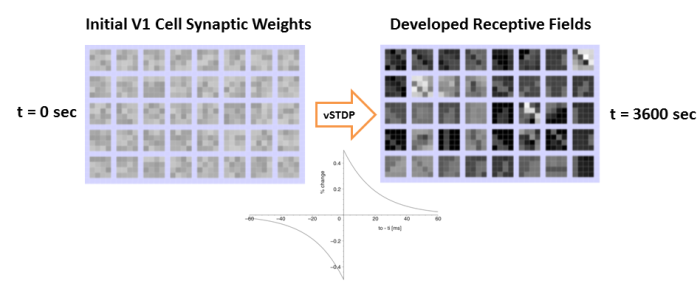SpikeFun 1.01 – Spontaneous emergence of orientation sensitivity in population of V1 cells with voltage-based Spike Timing Dependent Plasticity (STDP)
Click here to download DigiCortex demo...
Overview:
This article demonstrates ability to simulate naturally occurring phenomena with the DigiCortex engine, such as spontaneous development of orientation selectivity in the developing primary visual cortex (V1) when subjected to natural stimuli.
Experiment:
For this experiment, we created artificial spiking neural network consisting of 0.5 million multi-compartment cortical neurons (of pyramidal, spiny-stellate, basket and non-basket families) modeled using phenomenological Izhikevich adaptive quadratic integrate and fire model [1], arranged in six neocortical layers and using short-range connectivity statistics of cat primary visual cortex [2]. Cortical neurons are interconnected with approx. 100 million synaptic connections (of AMPA, NMDA, GABAa and GABAb types). All synaptic receptors exhibit short-term plasticity using Markram-Tsodyks model of synaptic release [3], while portion of the synaptic receptors also exhibit long-term synaptic plasticity modeled by voltage-based spike-timing dependent plasticity (vSTDP) using model of [4].
Cortical network receives driving and modulating afferents from the dorsal thalamus (core and matrix subpopulations of thalamic relay cells). Projections from the dorsal lateral geniculate nucleus (dLGN) are organized retinotopically and project to primary visual cortex. In turn, cortical network sends modulating efferents to the ventral thalamus (reticular thalamic nucleus) as well as driving efferents back to the dorsal thalamus. Thalamus itself receives driving visual input from the retinal ganglion cells (RGCs) divided in two layers (ON and OFF). RGC layers receive driving current from the Virtual Retina simulator, which is itself driven using natural video which was upconverted to 1000 frames per second (FPS) in order to match the simulation time step of 1 ms.

Driving projections from the dorsal thalamus (dLGN) to primary visual cortex are plastic and their synaptic weights evolve using voltage-based spike-timing dependent plasticity (vSTDP). Each L4 Spiny-Stellate cell of primary visual cortex receives input from 32 LGN thalamic relay cells (from 16 ‘ON’ and ‘OFF’ thalamic relay cells each, organized in two 4x4 retinotopically organized matrices)
Initially (ts=0), synaptic weights are chosen randomly and they are let to evolve by using vSTDP. Orientation sensitivity develops gradually without any intervention as it could be seen from the picture below:

Conclusion:
This simulation demonstrates that the vSTDP rule is sufficient for the development of orientation-sensitivity in the primary visual cortex when V1 cells are subjected to natural stimuli.
References
[1] Izhikevich E. M. (2010) Hybrid spiking models. Phil. Trans. R. Soc. A 368:5061–5070, (doi:10.1098/rsta.2010.0130)
[2] Binzegger T., Douglas R.J., Martin K.A.C. (2004) A Quantitative Map of the Circuit of Cat Primary Visual Cortex. Journal of Neuroscience, 24:8441-8453.
[3] Markram H, Wang Y, Tsodyks M (1998) Differential signaling via the same axon of neocortical pyramidal neurons. Proc Natl Acad Sci USA 95:5323–5328
[4] Clopath C, Büsing L, Vasilaki E, Gerstner W. Connectivity reflects coding: a model of voltage-based STDP with homeostasis. Nat. Neurosci. 2010;13:344–352.
- Log in to post comments

